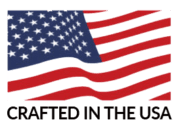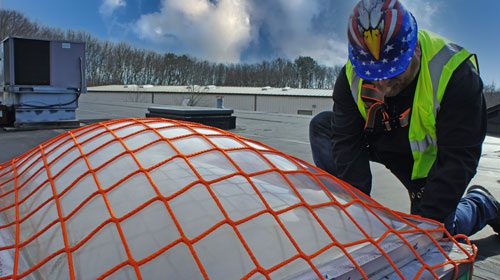Skylight Safety
Performing maintenance, installation, and inspection work on rooftops can be a risky business, mostly considering the risk of falling from such heights that can happen in the blink of an eye. Roof edges are considered the key hazard to avoid when performing roof work, however a second hazard type can be found on many roofs that presents an equivalent risk: skylights. For most industrial and commercial facilities, plastic or glass skylights are installed across roofs to allow in natural light, offsetting interior lighting electricity costs during the day. These fixtures are typically not rated for heavy weights and are very susceptible to being fallen through should an employee step, trip, or sit on one. In this article, we’ll discuss the risks involved with rooftop skylights, sources of regulatory requirements for skylight safety, and several suggestions for how to provide safe work access around skylights.
Risks Involved with Rooftop Skylights
From a safety standpoint, we’re best-off considering skylights to be no different than an open hole in a roof. Most skylights are not designed to bear weight, stop falling objects or people, take impact, or even withstand extreme weather. For these reasons, there are moderate risks involved in working around skylights that we’ll outline below.
- Falls: This article is primarily written around fall protection for skylights, on account of these risks having the highest potential for injuries and death. Workers can easily step or trip through skylights if they’re not watching their walking route, making fall protection for skylights a major necessity (more on this below). Skylights are not meant to carry any weight, and even sitting on the edge of a skylight curb to take a break can lead to a fall.
- Age-Related Failure: Skylights are typically made of thin, lightweight plastic that degrades over time from exposure to weather and sunlight. This aging can lead to cracks that leak, or worse, expand into large punctures which foreign objects can fall through. Small punctures are also notorious for being exploited by insects, rodents, and birds seeking access into the building.
- Weather Failure: Especially in areas that experience heavy snow, hail, and wind, skylights can fail under moderate to severe weather conditions without warning. Compounding the issue, some facilities will send maintenance folks up to clear snowpack off skylights, creating a very risky conditions of stepping right through a skylight when trying to locate it to clear off.
- Light and Temperature Pass-Through: While the main goal of a skylight is to pass light through (to save energy costs by keeping light fixtures turned off during the day), there are risks of having too much light pass through if it interferes with employee’s workflow or exposes them to excessive UV. An example of too much light passing through can be found in a sun-blinded corner along a forklift route during parts of the day. In the same vein, excess heat or cold from outside can be passed through skylights to worker or storage areas, creating uncomfortable environments and overused HVAC systems. Lastly, condensate may occur inside of a skylight due to relative humidity differences, leading to mold and other contamination.
Regulatory Requirements
We stated above that skylights are best viewed as equivalent to any opening in a roof, and modern safety regulations all tend to agree with this perspective. Skylights fall under safety standards regarding work surfaces, such as with OSHA’s 29 CFR Part 1910 Walking and Working Surfaces standards.
Before going further on safety regulations surrounding skylights, let’s point out that there are many other regulatory interests regarding skylights – structural, mechanical, energy, and more. For any projects involving skylights (both new installation and modifications to existing units), be sure to engage appropriate professionals to make sure all regulatory interests are fulfilled.
Starting with the United States’ Occupational Safety and Health Administration (OSHA), we turn to an Interpretation Letter from 1984 in which the agency states that “a skylight should be regarded as a hatchway, i.e., an opening in the roof of a building through which persons may fall”. The interpretation letter further clarified the applicable requirements placed on such skylights:
- Requires guarding by a standard skylight screen or fixed standard railing on all exposed sides
- A skylight screen must be capable of withstanding a load of at least 200 pounds
- Or a skylight with a plastic lens shall provide the structural integrity to support the 200-pound load itself, omitting the need for further safeguarding
- Screens protecting glass skylight lenses should also protect against glass deflection so that the glass does not shatter onto personnel below
In the early 2000s, OSHA conducted work towards revising their Walking and Working Surfaces standards, opening up provisions for allowing additional fall protection solutions including personal fall arrest, travel restraint, and positioning systems. These types of advances were aggregated into an updated Final Ruling issued to the Walking-Working Surfaces standards in 2017, found now in standard 1910 Subpart D. The key new code language is below:
- 1910.28 Duty to have fall protection and falling object protection
- 1910.28(b)(3)(i) – Each employee is protected from falling through any hole (including skylights) that is 4 feet (1.2 m) or more above a lower level by one or more of the following: covers, guardrail systems, travel restraint systems, or personal fall arrest systems
- 1910.29 Fall protection systems and falling object protection-criteria and practices
- 1910.29(e) – Covers. The employer must ensure each cover for a hole in a walking-working surface: is capable of supporting without failure, at least twice the maximum intended load that may be imposed on the cover at any one time; and is secured to prevent accidental displacement.
From the above current code, we can see that OSHA has switched to the more generic term ‘cover’ over the older term ‘screens’, presumably to allow more modern protective solutions to be employed. We can also see that the older 200-pound weight criteria has been replaced with verbiage describing ‘twice the maximum intended load’, again presumably to allow owners to specify higher ratings for special applications.
For any readers in California, the California Department of Industrial Relations has additional requirements for skylights.
For more information, refer to the American National Standard / ANSI A1264.1-2017 Safety Requirements for Workplace Walking/Working Surfaces and Their Access; Workplace, Floor, Wall and Roof Openings; Stairs and Guardrail/Handrail Systems. This standard adds additional requirements such as warning labeling, durability expectations equivalent to tempered glass glazing, and resistance testing per ASTM E695.
Example Solutions
Protecting employees from skylight hazards can take multiple forms, and should at minimum include engineering controls, warnings, administrative controls, and personal protective equipment.
- Engineering Controls: Guardrails, metal screens, and protective covers are all physical barriers that can keep employees from falling through skylights.
InCord’s Skylight Nets are especially viable solutions that are highly economical, easily installed, and made of long-life High Tenacity Polypropylene (HTPP) woven in a 4” square mesh pattern. This skylight netting is designed to safely contain up to a 1,000-pound load and are installed with a high-strength rachet strap around any 2” raised lip skylight curb. These nets are most often used as temporary safety devices installed when crews will be working near skylights, and easily removed and stored when not in use. Download our Skylight Net flyer here.
- Warnings: Safety signage, load-rating labels, and striped walking paths marked out on the roof are all viable warning methods that should be used near skylights.
Clearly defined roof walking paths are especially important and cannot be understated. Roofing materials and angles present plenty of risks on their own, often being steep, slippery, and compressible, leading to trips and falls. Installing marked walking paths using non-slip strips, tape, or rolls, and with reflective, bright colored perimeter tape along the edges, makes for a must safer and easily identifiable walking path for employees. In addition, these paths should be laid out to be more than 6’ from any skylight. On roofs that must be accessed when snow or airborne dust/sand are present, blocking visibility, path flags can be used to mark out walkways, and hazard flags can be used to mark out skylight locations.
- Administrative Controls: Employers should have detailed safe-work procedures for all rooftop tasks, and ample training should be provided for all employees, vendors, subcontractors, and visitors who will access a roof with skylights.
We further recommend that all roof work be performed in pairs, such that one worker can focus on spotting and safety at all times. Rotating workers through the spotter position, coupled with training exercises that allow work teams to practice spotting and communicating hazardous work conditions, allows all parties to be fully prepared and well-versed in how to manage their safety when working near skylights.
- Personal Protective Equipment: beyond normal workplace PPE of hardhats, gloves, safety-toe boots, hearing protection, eye protection, and so on, fall protection devices may be considered for use when working near skylights. When a skylight has no other method of protection (no guardrails, covers, etc), and when it is not clearly denoted that a skylight’s lens can withstand impact or load, employees must utilize personal fall protection devices to maintain their safety.
Lifeline systems are the most common personal fall restraint system deployed for temporary roof work near skylights lacking any other means of protection. Using engineered cabling and anchor points, workers will tie-off their harness and lanyard to these structural systems before performing work. While these systems are typically the most costly and complex, they are viable solutions when no other protective means can be utilized, when severe conditions call for the highest level of safety, or when lifeline systems are installed for permanent use.
About InCord
InCord manufactures custom safety netting solutions and lifting and rigging products for a range of industries. Our woman-owned Colchester, CT manufacturing plant is an ISO-9001 certified facility, housing a team ready to design and fabricate a unique netting solution to fit your needs. InCord was founded in 1995 and is a Connecticut Top Workplace. To discuss an application, request a quote, or obtain technical guidance, please call us at (860) 537-1414, submit a request here, or email us at netting@incord.com.






